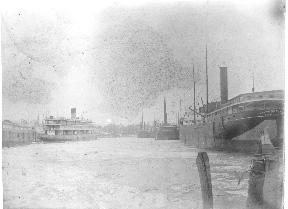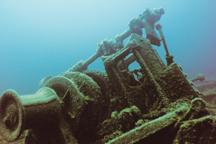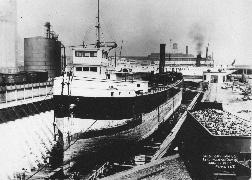Jon Paul’s Door County Maritime Diaries
- Share
- Tweet
- Pin
- Share
The last column featured the steamer Louisiana of the second generation of bulk carriers on the Great Lakes. This column is about the third and last generation of wooden bulk carriers and legendary shipbuilder James Davidson.
James Davidson started building ships in 1870 with the 3-masted schooner Laura Belle named after his daughter, built by the Baileys Brothers shipyard in Toledo, Ohio. The following year he would move to Bay City, Michigan and build ships on leased land until he could purchased land in Bay City for his shipyard in 1874. That year he would build his first steamer, the James Davidson, named after his eldest son, of 230’-7” long, 37’ in breadth with a 19’-7” depth of hold at 1,456 gross tons with 3 masts. Davidson would prosper over the years building large steamers and schooner barges with ever-increasing sizes.

The Frank O’Connor’s rudder and steering quadrant (left), propeller and horn timber (right). Photo by Kim Brungraber.
In 1891 Davidson would build what was dubbed the “Big Four,” the four largest steamers in the Great Lakes also known as the City Class. The City of Berlin, City of Glasgow, City of London and the City of Paris were just under 300’ at 298’x41’x21’. The following year Davidson would break the 300’ mark with his second city class ships, the City of Genoa, City of Naples and the City of Venice at 301’x42.42’x20’. These wooden behemoths of their day were competing with new steel freighters. Davidson would not convert to steel and kept competing with the new steel freighters by offering a steamer and her consort for less money and larger capacity than their steel counterparts.
The City of Naples was typical of the third generation wooden bulk carriers. It was powered by a triple expansion engine built by Detroit Dry Dock Engine Works. The engine cylinders were 20”, 33” and 50” diameter with a 42” stroke that turned the propeller at 85 revolutions per minute. Steam was provided by two Scotch boilers manufactured by Cleveland Shipbuilding and were 11 feet in diameter by 13 feet long and produced 160 pounds of pressure.

The City of Naples (right) with a whaleback steamer (left) in the Manitowoc River. Wisconsin Maritime Museum.
Davidson would operate the City of Naples in his own fleet for two years before selling the vessel along with her sister ship the City of Genoa to the J.C. Gilchrist Transportation Company. In 1895 the City of Naples was valued at $115,000 with an A1 insurance rating. In 1904 the company raised her deck by 18 inches, which increased her capacity from 2,109 gross tons to 3,300 tons.
In 1907 J.C. Gilchrist suffered a debilitating stroke and the company began a serious downslide; in 1913 the fleet was for sale under public auction and the City of Naples was purchased by Norris & Co. of Chicago and sold the following year to Tonawanda Iron and Steel Company. She was not registered in 1915 and was sold in 1916 to James L. O’Connor, a Tonawanda ship chandler who started the O’Connor Transportation Company. James would rename the vessel to Frank O’Connor after his son; the vessel would prove a good addition and made considerable profits during the First World War.

The steam powered windlass at the bow of the Frank O’Connor. Photo by Kim Brungraber.
The steamer Frank O’Connor was bound for Milwaukee with coal from Buffalo when on October 2, 1919 fire broke out. Fire aboard the O’Connor was first discovered about 4 o’clock in the afternoon. It broke out forward and its origin is a mystery. It started either in the forecastle or the chain locker. The oil room and paint locker were both forward but both were in steel compartments. The supposition is that the fire started from a cigarette butt or a match.
The boat was off Cana Island when the fire was discovered and about 10 miles from land. The blaze spread rapidly and the ship was a roaring furnace within a few minutes. The O’Connor had been carrying grain all season, until this trip when she had 3,000 tons of hard coal aboard, and her hold was caked with the dry dust of grain which burned like tinder. The O’Connor headed for land immediately; it was seen she was doomed and the crew stayed aboard an hour. Finally, the steam steering gear burned and all control of the boat was lost.

The City of Venice, sister ship of the City of Naples, being launched in 1892 at Bay City, Michigan. Photo Courtesy of Bay County Historical Society.
Just as the crew was about to take to the life boats, Keeper Oscar H. Knudson of the Cana Island light and his assistant, Louis Picon, hove in sight in their power boat and gave valuable assistance to the crew, loading the greater part of the dunnage in the power boat and taking the two lifeboats of the O’Connor in tow. The Baileys Harbor coast guard station crew, having been notified of the burning boat, met the tow and took the life boats to Baileys Harbor. From there the crew was taken to Sturgeon Bay. The O’Connor was valued at $25,000 and the cargo at $30,000.
Gardner Karker of Sturgeon Bay who was firing on the O’Connor, remained at his old home here after the wreck. This is his second shipwreck within 15 months, but this was the only time he landed directly in his old hometown upon being rescued. His other experience was infinitely more exciting. That was the wreck of the cargo steamer Cream City, which went down near Kitchner Island on Lake Huron in July 1918.

The City of Venice, sister ship of the City of Naples, being launched in 1892 at Bay City, Michigan. Photo Courtesy of Bay County Historical Society.
The O’Connor Transportation Company was sold by the family after the loss of the Frank O’Connor. The vessel was located in the 1930s and her cargo of hard coal was salvaged by use of a claim shell. Rediscovered in 1990 by mistake from a group looking for the lost schooner King, she is now the premier dive site in Door County.
Shipbuilder James Davidson would build 103 ships in his yard at Bay City, Michigan; the last large vessel was built in 1903.
Fire aboard these early wooden steam bulk carriers was always a threat, and owing to the cargos carried by these vessels it is not surprising that all three of the James Davidson-built steamers, and the two generations of vessels in the last two columns that lie in the waters of Door County, ended their careers as steamers on account of it.
The early bulk carriers would normally leave Buffalo, Cleveland and other easterly ports loaded with coal or salt, down bound for Chicago, Milwaukee and other ports to deliver their cargo and return east with grain or corn from the Midwest or iron ore from the northern Michigan range. This very volatile mixture of coal dust and grain dust would take its toll on freighters. The Australasia (Oct. 1896), City of Glasgow (Dec. 1907) and the Frank O’ Connor (formally the City of Naples, Oct. 1919) – all were carrying coal on their final voyages and all met a similar fate.

